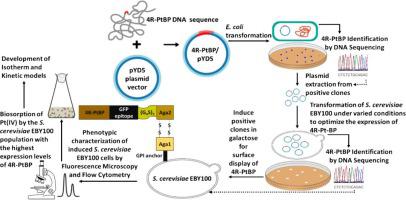当前位置:
X-MOL 学术
›
Miner. Eng.
›
论文详情
Our official English website, www.x-mol.net, welcomes your feedback! (Note: you will need to create a separate account there.)
Biomolecular mechanism in the uptake of Pt(IV) by Saccharomyces cerevisiae EBY100 cells expressing platinum binding peptides
Minerals Engineering ( IF 4.9 ) Pub Date : 2024-06-08 , DOI: 10.1016/j.mineng.2024.108735 Boitumelo F. Mashangoane , Evans M. Nkhalambayausi Chirwa , Brian Gidudu
Minerals Engineering ( IF 4.9 ) Pub Date : 2024-06-08 , DOI: 10.1016/j.mineng.2024.108735 Boitumelo F. Mashangoane , Evans M. Nkhalambayausi Chirwa , Brian Gidudu

|
Platinum group metals (PGMs) are currently under increased demand due to limited availability and their unique properties; therefore, their limited availability presents an economically attractive opportunity to recover these metals from waste. The recovery of PGMs from effluents using conventional techniques such floatation, precipitation and ion exchange results in large volumes of hazardous waste as well as high operating costs and low efficiencies. Biosorption using biomass such as microorganisms as adsorbents can offer a cheap, efficient and environmentally friendly alternative for the recovery of PGMs. Despite previous research on the use of biosorption techniques for the recovery of PGMs; there is still room for improvement in the way that microorganisms absorb metals. Such advancements can be achieved through the use of genetically engineered peptides for inorganics (GEPI) for cell surface display purposes. In this work, EBY100 cells were genetically engineered for cell surface display of platinum binding peptides to enable Pt(IV) adsorption from an aqueous solution. The transformed EBY100 cells attained the maximum adsorption of 40 % for Pt(IV) after 3 h at the optimal pH = 3. As the initial metal concentration rose from 10 ppm to 50 ppm, the biosorption Pt(IV) increased as well, reaching a biosorption capacity of 85 mg/g. The findings also showed that the Freundlich model best explained the Pt(IV) biosorption isotherm onto P3.1, while the pseudo-second-order model best explained the Pt(IV) adsorption kinetics onto P3.1.
中文翻译:

表达铂结合肽的酿酒酵母 EBY100 细胞摄取 Pt(IV) 的生物分子机制
由于供应有限且具有独特的性能,铂族金属 (PGM) 目前的需求量不断增加;因此,它们的有限可用性为从废物中回收这些金属提供了一个具有经济吸引力的机会。使用浮选、沉淀和离子交换等传统技术从废水中回收铂族金属会产生大量危险废物,并且运营成本高、效率低。使用微生物等生物质作为吸附剂的生物吸附可以为铂族金属的回收提供廉价、高效且环保的替代方案。尽管之前有关于使用生物吸附技术回收铂族金属的研究;微生物吸收金属的方式仍有改进的空间。这些进步可以通过使用基因工程无机肽(GEPI)用于细胞表面展示来实现。在这项工作中,EBY100 细胞经过基因工程改造,可在细胞表面展示铂结合肽,从而能够从水溶液中吸附 Pt(IV)。在最佳 pH = 3 下 3 小时后,转化的 EBY100 细胞对 Pt(IV) 的最大吸附达到 40%。随着初始金属浓度从 10 ppm 上升到 50 ppm,Pt(IV) 的生物吸附也增加,达到生物吸附能力为 85 mg/g。研究结果还表明,Freundlich 模型最好地解释了 P3.1 上的 Pt(IV) 生物吸附等温线,而伪二阶模型最好地解释了 P3.1 上的 Pt(IV) 吸附动力学。
更新日期:2024-06-08
中文翻译:

表达铂结合肽的酿酒酵母 EBY100 细胞摄取 Pt(IV) 的生物分子机制
由于供应有限且具有独特的性能,铂族金属 (PGM) 目前的需求量不断增加;因此,它们的有限可用性为从废物中回收这些金属提供了一个具有经济吸引力的机会。使用浮选、沉淀和离子交换等传统技术从废水中回收铂族金属会产生大量危险废物,并且运营成本高、效率低。使用微生物等生物质作为吸附剂的生物吸附可以为铂族金属的回收提供廉价、高效且环保的替代方案。尽管之前有关于使用生物吸附技术回收铂族金属的研究;微生物吸收金属的方式仍有改进的空间。这些进步可以通过使用基因工程无机肽(GEPI)用于细胞表面展示来实现。在这项工作中,EBY100 细胞经过基因工程改造,可在细胞表面展示铂结合肽,从而能够从水溶液中吸附 Pt(IV)。在最佳 pH = 3 下 3 小时后,转化的 EBY100 细胞对 Pt(IV) 的最大吸附达到 40%。随着初始金属浓度从 10 ppm 上升到 50 ppm,Pt(IV) 的生物吸附也增加,达到生物吸附能力为 85 mg/g。研究结果还表明,Freundlich 模型最好地解释了 P3.1 上的 Pt(IV) 生物吸附等温线,而伪二阶模型最好地解释了 P3.1 上的 Pt(IV) 吸附动力学。






































 京公网安备 11010802027423号
京公网安备 11010802027423号